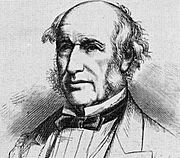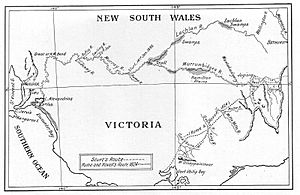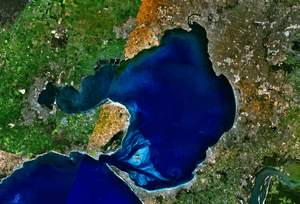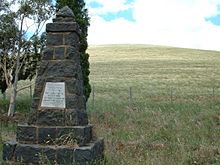William Hovell facts for kids
Quick facts for kids
William Hilton Hovell
|
|
|---|---|

William Hovell
|
|
| Born | April 26, 1786 |
| Died | November 9, 1875 |
William Hilton Hovell (born April 26, 1786 – died November 9, 1875) was an English explorer. He is famous for exploring parts of Australia. He traveled a lot of Victoria with another explorer named Hamilton Hume.
Contents
Early Life of William Hovell
William Hovell was born in Great Yarmouth, Norfolk, England. He joined the Royal Navy and became a ship captain. In October 1813, he moved to New South Wales with his wife, Esther Arndell.
He worked as a ship captain, making many trading trips. He sailed along the coast of Australia and even to New Zealand. In 1816, his ship was wrecked in Bass Strait. By 1819, he lived near Sydney. He started exploring areas to the south. In 1823, he reached the Burragorang Valley.
Exploring Southern Australia
In 1824, Governor Sir Thomas Brisbane asked Hovell to join Hamilton Hume. Their mission was to explore the southern parts of New South Wales and Victoria. The Governor wanted to find out if there were any rivers flowing south. Hovell was not an explorer by trade. However, he was very good at finding his way using maps and tools.
There were some issues about who would pay for the trip. So, the two explorers bought most of their own gear. The government helped by giving them saddles, clothes, blankets, and guns.
The Journey Begins
Hume and Hovell left Sydney on October 3, 1824. They had six men, five bullocks, three horses, and two carts with them. When they reached the Murrumbidgee River, it was flooded. They had to turn one of their carts into a makeshift boat to cross. The men, horses, and bullocks swam across.
A few days later, they faced rough, hilly land. It was very hard to find a path for their carts. On October 27, they decided to leave the carts behind.
Reaching New Rivers
On November 16, they found a large river. Hovell named it Hume's River. He did this because Hume was the first to see it. This river was later renamed the Murray River by Charles Sturt. It was impossible to cross the river where they were. This was near the town of Albury. After a few days, they found a better spot. They built a simple boat frame and managed to get across.
By December 3, they had reached the Goulburn River. The next ten days were tough. They traveled through difficult country. But eventually, they reached more flat and open land.
Discovering Corio Bay
On December 16, they saw Port Phillip Bay. They traveled along its shores towards the southwest. They arrived at what is now Corio Bay, near Geelong. Hovell made a small mistake in his calculations. The explorers thought they were at Western Port.
The group started their return journey on December 18. They took an easier path, heading more to the west. By January 8, 1825, they had run out of food. For a few days, they ate fish and a kangaroo they managed to shoot. On January 16, they reached the carts they had left behind. Two days later, they arrived back at Lake George.
Exploring Western Port
On March 25, Governor Brisbane wrote to England about Hovell and Hume's discoveries. He said he would send a ship to explore Western Port. Later, Governor Ralph Darling sent an expedition to Western Port in late 1826. Captain Wright led this trip, and Hovell went along. It was on this trip that Hovell's earlier mistake in location was found.
Hovell explored the land around Western Port and to the north. Near the coast at Cape Paterson, he found "great quantities of very fine coal". This was the first time coal was discovered in Victoria. Hovell was away for five months on this expedition.
He tried for the next ten years to get a special reward from the government. He had already received land for his trips. He got 1,200 acres (about 5 square kilometers) for the trip with Hume. He also got 1,280 acres (about 5 square kilometers) for the Western Port trip. But he felt this was not enough.
Later Life and Legacy
William Hovell spent the rest of his life on his farm in Goulburn, New South Wales. He married Sophia Wilkinson in 1848.
In December 1853, Hovell was a special guest at a public dinner in Geelong, Victoria. His speech was reported in newspapers. Hamilton Hume thought Hovell was trying to take all the credit for their shared expedition. This led to a long and public argument between the two men. However, a full report of the speech showed that Hume was mistaken.
Hume was a skilled leader in the bush. Hovell was well-educated and had a friendly personality. During their expedition, they worked well together. They were responsible for a very important journey of exploration. Hovell's discovery of coal at Western Port was also a significant finding.
Hovell died in Sydney on November 9, 1875. He was buried in Goulburn. In 1877, his wife left £6000 to the University of Sydney. This money was a memorial to him. It was used to start the William Hilton Hovell lectureship, which teaches about geology and physical geography.
Recognition of William Hovell
In 1922, a group in Melbourne started planning to celebrate 100 years since the expedition. Along the path of their journey, 37 memorials were built in Victoria.
A dam was built on the King River near Cheshunt, Victoria in 1973. This dam created Lake William Hovell. It provides water for crops, vineyards, and farms along the King River from Cheshunt to Wangaratta.
A River Redgum tree in Albury still has a mark Hovell made in 1824. He carved "Hovell NovR17/24" into the tree. This tree has been cloned. This means copies of it have been grown to keep its genes safe for the future.
An iron treasure chest, made in Germany around 1660, once belonged to Hovell. It is now in the Powerhouse Museum in Sydney. The Hume and Hovell Walking Track has been created. It follows the explorers' path from Yass to Albury.
Related pages
See also
 In Spanish: William Hovell para niños
In Spanish: William Hovell para niños




